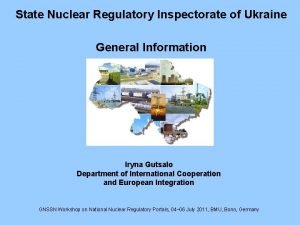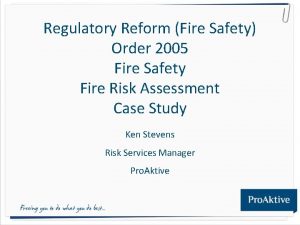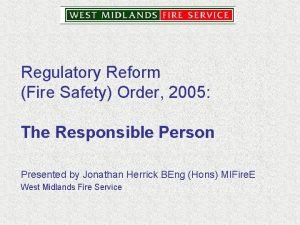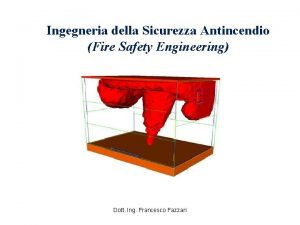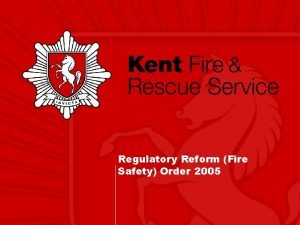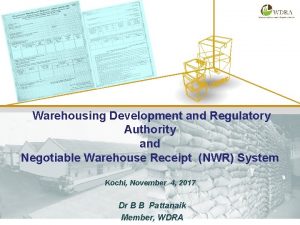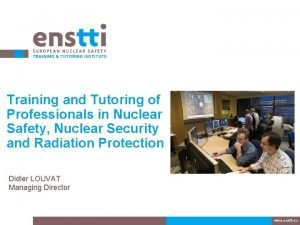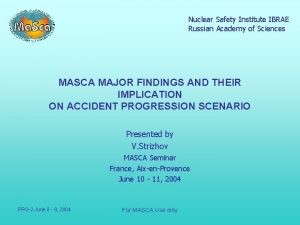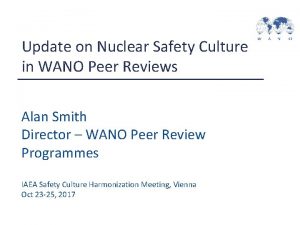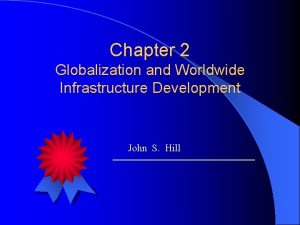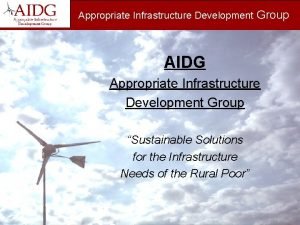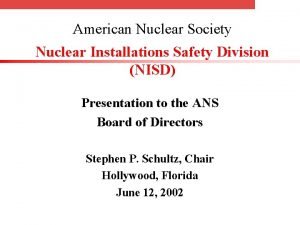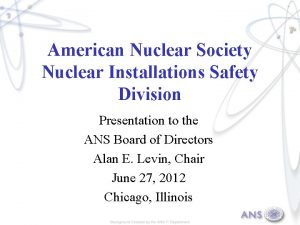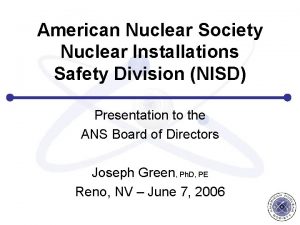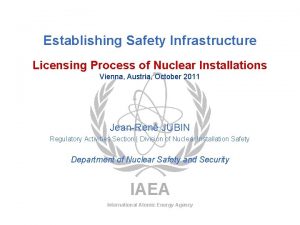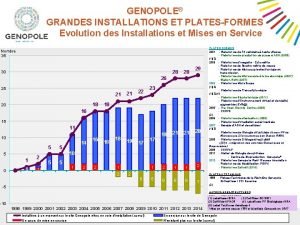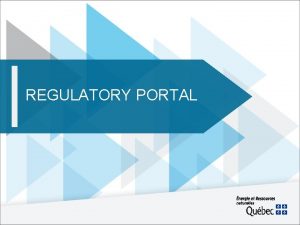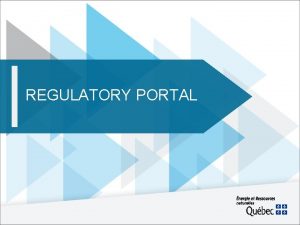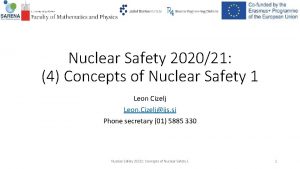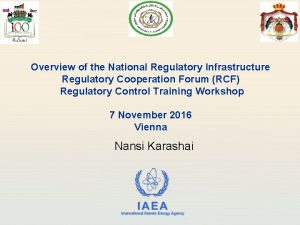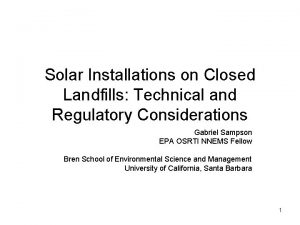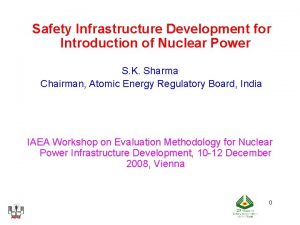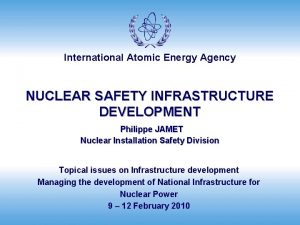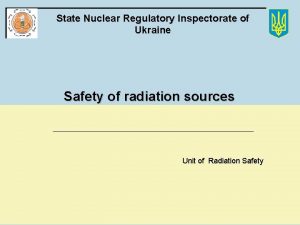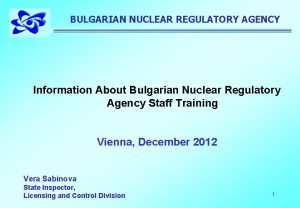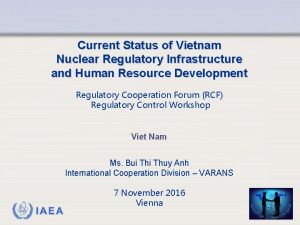Regulatory Infrastructure Development for Safety of Nuclear Installations






















- Slides: 22

Regulatory Infrastructure Development for Safety of Nuclear Installations RCF Plenary Meeting 30 September 2016 Vienna, Austria Greg RZENTKOWSKI, Director Division of Nuclear Installation Safety Nuclear Safety and Security Department

Nuclear Power Development Long-term government commitment • National infrastructure • Qualified/skilled human resources Social • High up-front investment Bearable Equitable Sustainab le Environment Viable • Public acceptance Economic Global impact • High level of safety and security • Control of nuclear materials • Long-term waste management

National Commitment to Safety • Safety is the national responsibility and cannot be outsourced • Safety is an essential condition for a sustainable and successful nuclear power programme • Safety is an integral component in all infrastructure issues • Safety has to be continuously improved • A safety culture starting with strong and effective leadership is essential • Weak links need to be identified and strengthened

International Obligations Convention on Nuclear Safety ü Adopted in June 1994 and entered into force in October 1996 ü There are 78 Contracting Parties and 10 Signatory States ü 7 th Review Meeting of the Convention will be held in 2017 • ARTICLE 8. REGULATORY BODY ü Each Contracting Party shall establish or designate a Regulatory Body entrusted with the implementation of the legislative and regulatory framework • ARTICLE 9. RESPONSIBILITY OF THE LICENSE HOLDER ü Each Contracting Party shall ensure that prime responsibility for the safety of a nuclear installation rests with the holder of the relevant licence and shall take the appropriate steps to ensure that each such licence holder meets its responsibility 4

Regulatory Infrastructure Development IAEA Assistance • Safety Standards • ü Safety fundaments, requirements and guides • Peer Reviews • Advisory Services ü Guidance on establishing safety infrastructure • • Capacity Building Nuclear Power Plants Research Reactors Fuel Cycle Facilities Provide services for implementation of safety standards ü Peer-reviews and advisory services • • Develop internationally recognized safety standards Provide quality support and assistance to Member States developing safety infrastructure ü Capacity building (training courses, workshops, fellowships and scientific visits) • Coordinate and collaborate effectively with other organizations

IAEA Safety Standards The IAEA safety standards provide requirements that should be met for the establishment of an adequate and effective regulatory infrastructure for safety 6

Fundamental Safety Principles Primary safety objective: Protection of people and the environment from harmful effects of ionizing radiation • Principle 1: Responsibility for safety • Principle 2: Role of government • Principle 3: Leadership and management for safety Ten safety principles form the basis on which safety requirements are developed and safety measures are implemented to achieve the primary safety objective • Principle 4: Justification of facilities and activities • Principle 5: Optimization of protection • Principle 6: Limitations of risks to individuals • Principle 7: Protection of present and future generations • Principle 8: Prevention of accidents • Principle 9: Emergency preparedness and response • Principle 10: Protective actions to reduce existing or unregulated radiations risks must be justified and optimized

General Safety Requirements GSR Part 1: Governmental, Legal and Regulatory Framework for Safety • Fundamental requirements for development of safety framework • Criteria for self-assessment of completeness and adequacy of safety infrastructure • Rev. 1 published in February 2016 Supporting Safety Guides in preparation: • DS 472 Organization, Management and Staffing of a Regulatory Body for Safety • DS 473 Functions and Processes of the Regulatory Body for Safety are under development to support GSR Part 1 8

Specific Safety Guide SSG-16: Establishing the Safety Infrastructure for a Nuclear Power Programme 20 elements • • • 20 safety elements supported by 200 actions to be taken Each safety element is fully based on relevant IAEA safety standards; GSR Part 1 for safety elements 1 -7 and 20 For each action, responsibilities are clearly stated 1. National policy and strategy for safety 2. Global nuclear safety regime 3. Legal framework 4. Regulatory framework 5. Transparency and openness 6. Funding and financing 7. External support organizations and contractors 8. Leadership and management for safety 9. Human resources development 10. Research for safety and regulatory purposes 11. Radiation protection 12. Safety assessment 13. Safety of radioactive waste management, spent fuel management and decommissioning 14. Emergency preparedness and response 15. Operating organization 16. Site survey, site selection and evaluation 17. Design safety 18. Preparation for commissioning 19. Transport safety 20. Interfaces with nuclear security 9

Prioritization of Regulations • • Site evaluation Radiation Protection Licensing Process Management system • Design • Basic regulations on - Construction - Manufacturing - Waste Management - Emergency Preparedness 10

Safety Review Services (1/2) Safety of Nuclear Installations Peer-review Services IRRS • Integrated Regulatory Review Service (IRRS) • Site and External Events Design (SEED) • Operational Safety Review Service (OSART) • Integrated Safety Assessment of Research Reactor (INSARR) • Safety Evaluation during Operation of Fuel Cycle Facilities (SEDO) • Safety Aspects of Long Term Operation (SALTO) Advisory Services • Safety Assessment Advisory Programme (SAAP) • Technical Safety Review Services (TSR)

Safety Review Services (2/2) Conduct of Safety Review Services Review Basis • • • IAEA safety standards form the basis Open and transparent Lead by IAEA staff and international experts Benefits of Safety Review Services • Improvement in regulation of nuclear installations and in their operational safety ü Sharing knowledge and good practices ü Disseminating lessons learned from the Fukushima. Daiichi accident ü Providing opportunities for improvements • Impact on governments, regulators and operators

Integrated Regulatory Review Service (1/2) Key objectives Modular Structure • Strengthen and enhance the effectiveness of national regulatory infrastructure for nuclear, radiation, radioactive waste and transport safety and the security of radioactive sources • Assess the status of national regulatory infrastructure against IAEA safety standards. • Enhance nuclear and radiation safety and regulatory effectiveness Main scope • All regulated nuclear facilities and activities • Tailored module for embarking countries to asses regulatory infrastructure development (based on SSG 16)

Integrated Regulatory Review Service (2/2) Safety achievements 1200 Recommendations 1000 Suggestions 800 600 400 200 . 3 2 -1 SG G G S- R- . . . et y a. . n io ia t Ra d as W Sa f St ty te S af e ta r. S th e O . ds ar nd SG SR Pa rt R- 1 3 0 G Number of References General Observations • Regulatory Body’s independence • Clarification of Regulatory Body authority, role and responsibilities • Regulations and regulatory guidance • Regulatory Body management system, including better procedures and training Opportunities for further improvements • National policies and strategies for safety • Development of regulations and guides • Procedures and guidance for authorization, review and assessment

Self-Assessment Tools Self-Assessment of Regulatory Infrastructure for Safety (SARIS) • Focused on countries with established nuclear power programmes • Question-sets based on safety requirements • About 560 questions for preparation of IRRS ü Recently revised Integrated Review of Infrastructure for Safety (IRIS) • Focused on countries embarking on nuclear power programmes • Question-sets based on 200 SSG-16 Actions • For each Action: ü Primary question (yes/no) ü Subsidiary questions to assist creation of national action plan 15

Capacity Building Education and Training Strategy SSG-16 organizes 11 thematic modules Member States’ taking ownership of developing and implementing a national strategy Objective § § § Sustainability of national programs Train the trainers Self-learning and training courses Scope § Safety infrastructure for nuclear power program 16

Basic Safety Training Scope • Basic safety concepts and their application to NPPs, Research Reactors and Fuel Cycle Facilities Focus • Basic principles and key issues of importance to nuclear safety • • • Radiation protection in nuclear facilities Design of a nuclear reactor, interfaces with security; Safety classification of structures, systems and components Deterministic accident analysis and probabilistic safety analysis Links between probabilistic, deterministic analysis and risk informed decision making Siting and environmental impact assessment Operational safety, including operational feedback Limiting conditions for operation Public communication 17

Basic Professional Training Course Nuclear Safety • Designed to provide a broad overview of all the safety concepts and their application to nuclear power plants and research reactors design and operation • Intended for junior professionals recently involved in nuclear safety-related activities and highly specialized professionals who lack a broader view of nuclear safety. • Reviewed and revised into a 23 module course, incorporating the latest IAEA Safety Standards. • Designed to be delivered in 1 month (short course) or 3 months (long course) 18

Inspector Workshop Objective • Hands-on training programme to provide an introduction on inspection skills and methods • Designed to place participants in simulated, real-life scenarios Learning aspects • • • Fundamentals of inspection An overview of the basic information required for inspections How to perform general plant walk-down inspections How to perform basic system walk-down inspections How to conduct maintenance inspections 19

International cooperation • Regulatory Cooperation Forum • IAEA regional networks ü Asian Nuclear Safety Network (ANSN) ü Arab Network of Nuclear Regulators (ANNu. R) ü Forum for Nuclear Regulatory Bodies in Africa (FNRBA) ü Ibero-American Forum of Nuclear and Radiation Safety and Security Regulatory Agencies (FORO) • IAEA Technical Cooperation • Practical collaboration among IAEA frameworks, EC and WANO to enhance nuclear safety in more effective and efficient way IAEA appreciates significant support received from extra-budgetary contributions 20

Summary • A nuclear power programme is a major undertaking that requires careful planning, preparation and investment • Safety is the national responsibility and cannot be outsourced • IAEA provides assistance with regulatory infrastructure development for safety through: ü Assisting in implementation of legal instruments ü Publishing international recognized standards and providing for their implementation ü Facilitating international collaboration to strengthen safety ü Fostering exchange of experience among regulators ü Supporting embarking Member States in a systematic and coordinated manner • Measurable achievement in strengthening nuclear safety and enhancing regulatory effectiveness globally ü More than 70 IRRS missions conducted since 2006 ü High level of implementation of recommendations and suggestions 21

Thank you!
 Art installations
Art installations Contoh embedded system stand alone
Contoh embedded system stand alone Rhipe architecture
Rhipe architecture Infoatoms
Infoatoms Lesson 15 nuclear quest nuclear reactions
Lesson 15 nuclear quest nuclear reactions Fisión nuclear vs fision nuclear
Fisión nuclear vs fision nuclear Regulatory reform fire safety order 2005
Regulatory reform fire safety order 2005 The regulatory reform (fire safety) order 2005 summary
The regulatory reform (fire safety) order 2005 summary Ingegneria sicurezza antincendio
Ingegneria sicurezza antincendio Regulatory reform (fire safety) order 2005 article 8 to 23
Regulatory reform (fire safety) order 2005 article 8 to 23 Warehousing development and regulatory authority
Warehousing development and regulatory authority Nuclear safety training
Nuclear safety training Nuclear safety institute of the russian academy of sciences
Nuclear safety institute of the russian academy of sciences Nuclear safety culture
Nuclear safety culture Svpt uni wuppertal
Svpt uni wuppertal Development of infrastructure in globalization
Development of infrastructure in globalization Appropriate infrastructure development group
Appropriate infrastructure development group Fspos vägledning för kontinuitetshantering
Fspos vägledning för kontinuitetshantering Novell typiska drag
Novell typiska drag Nationell inriktning för artificiell intelligens
Nationell inriktning för artificiell intelligens Ekologiskt fotavtryck
Ekologiskt fotavtryck Varför kallas perioden 1918-1939 för mellankrigstiden?
Varför kallas perioden 1918-1939 för mellankrigstiden? En lathund för arbete med kontinuitetshantering
En lathund för arbete med kontinuitetshantering



